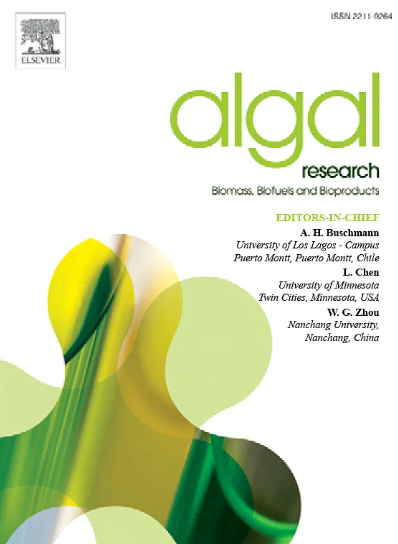Biodegradation of N-Methylpyrrolidone (NMP) with a rotating algae-bacterial biofilm system
IF 4.6
2区 生物学
Q1 BIOTECHNOLOGY & APPLIED MICROBIOLOGY
Algal Research-Biomass Biofuels and Bioproducts
Pub Date : 2025-06-20
DOI:10.1016/j.algal.2025.104161
引用次数: 0
Abstract
N-Methyl-2-pyrrolidone (NMP) is widely used in the lithium battery manufacturing industry, and residual NMP is discharged with production wastewater. Traditional physicochemical methods for treating NMP-containing wastewater face challenges such as high energy consumption, complex operations, and environmental risks. Considering NMP as a nitrogenous heterocyclic compound, this research investigated the potential of an algal-bacterial symbiotic system for the effective treatment of NMP wastewater. In this treatment approach, NMP was used as the exclusive source of nitrogen and carbon in the wastewater. The results demonstrated that in sequential batch experiments with NMP concentrations of 1000 mg/L and 4000 mg/L, removal efficiencies of COD, TOC, and TN all exceeded 95 %. Ammonium nitrogen produced from NMP degradation was efficiently absorbed by the algae within the biofilm, ensuring that the treated effluent met the wastewater discharge standards of the lithium battery industry. In semi-continuous flow experiments, maintaining a HRT of 72 h resulted in average removal efficiency of COD, TOC, and TN for 1000 mg/L NMP wastewater at 70.9 ± 3.7 %, 92.4 ± 0.7 %, and 37.8 ± 8.9 %, respectively. Microbial community analysis revealed that the presence of NMP enhanced the species richness within the biofilm. Heterotrophs Chitinophagales,Phormidesmiales were the most abundant bacteria, likely contributing to TOC degradation, while autotrophs Phormidesmiales and Trebouxiophyceae, Chlorella, Chloroflexales, Chloronema potentially playing a role in ammonium nitrogen absorption and fixation. The presence of protists and micro-metazoans such as Amphileptus, Rhabditida and Phascolodon, within the biofilms demonstrates a more complete biological chain within the biofilms, which contributes to the removal of pollutants from the wastewater. These insights offer a novel biological treatment technology for the efficient management of lithium battery wastewater.

旋转藻-细菌生物膜系统降解n -甲基吡咯烷酮(NMP)的研究
n -甲基-2-吡咯烷酮(NMP)广泛应用于锂电池制造业,其残留随生产废水一起排放。传统的物理化学方法处理含nmp废水面临着高能耗、复杂操作和环境风险等挑战。考虑到NMP是一种含氮杂环化合物,本研究探讨了藻类-细菌共生系统有效处理NMP废水的潜力。在该处理方法中,NMP被用作废水中氮和碳的唯一来源。结果表明,在NMP浓度为1000 mg/L和4000 mg/L的连续间歇式实验中,COD、TOC和TN的去除率均超过95%。NMP降解产生的氨氮被生物膜内的藻类有效吸收,确保处理后的废水达到锂电池行业的废水排放标准。在半连续流实验中,维持72 h的HRT对1000 mg/L NMP废水的COD、TOC和TN的平均去除率分别为70.9±3.7%、92.4±0.7%和37.8±8.9%。微生物群落分析表明,NMP的存在增加了生物膜内的物种丰富度。异养的几丁噬菌(Chitinophagales)、Phormidesmiales数量最多,可能对TOC的降解起作用,而自养的Phormidesmiales和Trebouxiophyceae、小球藻(Chlorella)、Chloroflexales、Chloronema可能对铵态氮的吸收和固定起作用。生物膜内原生生物和微后生动物如Amphileptus、Rhabditida和phascoldon的存在表明生物膜内的生物链更完整,有助于去除废水中的污染物。这些见解为锂电池废水的有效管理提供了一种新的生物处理技术。
本文章由计算机程序翻译,如有差异,请以英文原文为准。
求助全文
约1分钟内获得全文
求助全文
来源期刊

Algal Research-Biomass Biofuels and Bioproducts
BIOTECHNOLOGY & APPLIED MICROBIOLOGY-
CiteScore
9.40
自引率
7.80%
发文量
332
期刊介绍:
Algal Research is an international phycology journal covering all areas of emerging technologies in algae biology, biomass production, cultivation, harvesting, extraction, bioproducts, biorefinery, engineering, and econometrics. Algae is defined to include cyanobacteria, microalgae, and protists and symbionts of interest in biotechnology. The journal publishes original research and reviews for the following scope: algal biology, including but not exclusive to: phylogeny, biodiversity, molecular traits, metabolic regulation, and genetic engineering, algal cultivation, e.g. phototrophic systems, heterotrophic systems, and mixotrophic systems, algal harvesting and extraction systems, biotechnology to convert algal biomass and components into biofuels and bioproducts, e.g., nutraceuticals, pharmaceuticals, animal feed, plastics, etc. algal products and their economic assessment
 求助内容:
求助内容: 应助结果提醒方式:
应助结果提醒方式:


